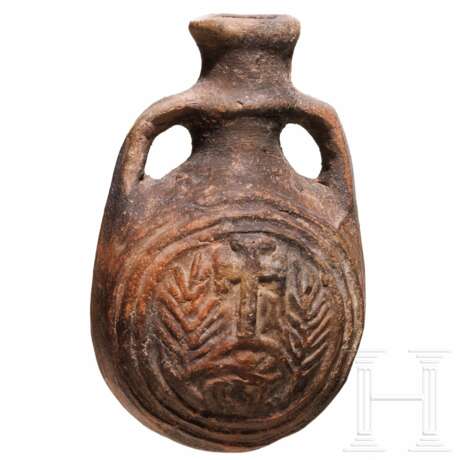ID 1260067
Lot 8052 | Frühbyzantinisches Pilgerfläschchen, modelgeformter Ton, 6. - 7. Jhdt.
Aus zwei modelgeformten Hälften zusammengesetztes Fläschchen mit rundem Korpus. Darüber zylindrischer Hals mit Mittelrippe und nach außen gestellter, wulstiger Randlippe. Von der Mittelrippe ausgehend seitlich zwei bandförmige Henkel, die zur Schulter der Flasche hinabgeführt sind. Auf dem runden Korpus auf einer Seite ein Kreuz auf Berg (Golgotha), darunter wohl die Öffnung eines Felsgrabes (Grab Christi). Seitlich zwei Palmzweige als Symbole des Sieges Christi über den Tod. Auf der anderen Seite Medaillon mit bärtiger Büste (Christus oder Heiliger), unten eingefasst von zwei Zweigen, oben schwer zu deutender Schriftzug. Glimmerhaltiger, rötlicher Ton mit dunklen Flecken. Auf den Höhen partiell minimal berieben, sonst tadelloser, intakter Zustand. Höhe 10,5 cm.
Provenienz: Thüringische Privatsammlung, erworben im süddeutschen Kunsthandel Anfang des Jahrtausends.
An early Byzantine pilgrim's bottle, mould-shaped ceramic, 6th - 7th century
An early Byzantine pilgrim's bottle, mould-shaped ceramic, 6th - 7th century
Aus zwei modelgeformten Hälften zusammengesetztes Fläschchen mit rundem Korpus. Darüber zylindrischer Hals mit Mittelrippe und nach außen gestellter, wulstiger Randlippe. Von der Mittelrippe ausgehend seitlich zwei bandförmige Henkel, die zur Schulter der Flasche hinabgeführt sind. Auf dem runden Korpus auf einer Seite ein Kreuz auf Berg (Golgotha), darunter wohl die Öffnung eines Felsgrabes (Grab Christi). Seitlich zwei Palmzweige als Symbole des Sieges Christi über den Tod. Auf der anderen Seite Medaillon mit bärtiger Büste (Christus oder Heiliger), unten eingefasst von zwei Zweigen, oben schwer zu deutender Schriftzug. Glimmerhaltiger, rötlicher Ton mit dunklen Flecken. Auf den Höhen partiell minimal berieben, sonst tadelloser, intakter Zustand. Höhe 10,5 cm.
Provenance: Thüringische Privatsammlung, erworben im süddeutschen Kunsthandel Anfang des Jahrtausends.
Condition: I - II
| Auction house category: | Byzantium and the Middle Ages in Southeastern Europe |
|---|
| Auction house category: | Byzantium and the Middle Ages in Southeastern Europe |
|---|
| Address of auction |
Hermann Historica Bretonischer Ring 3 85630 Grasbrunn / München Germany | ||||||||||||||
|---|---|---|---|---|---|---|---|---|---|---|---|---|---|---|---|
| Preview | |||||||||||||||
| Phone | +49 (0)89 5472 649 0 | ||||||||||||||
| Fax | +49 (0)89 5472 64999 | ||||||||||||||
| Buyer Premium | 25 % | ||||||||||||||
| Conditions of purchase | Conditions of purchase | ||||||||||||||
| Business hours | Business hours
|






